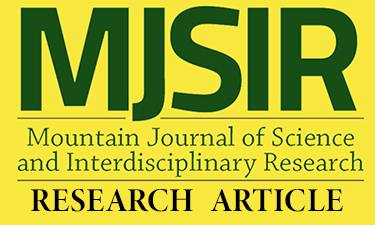Isolation, Characterization, Identification, and Preliminary Pathogenicity Test of Entomopathogenic Fungi Against Whitefly (Bemesia tabaci)
Main Article Content
Abstract
Whitefly can transmit many plant viruses to vulnerable vegetable crops such as cabbage, white potato, and chayote. It has been reported to develop resistance to a wide range of insecticides. This study was conducted to isolate entomopathogenic fungi (EPF) from insect cadavers, identify and characterize theisolated EPF through cultural and morphological characterizations and conduct a preliminary pathogenicity test of at least one of the identified EPF on whitefly. Samples of EPF from the BSU Pomology were initially identified and characterized as Aschersonia placenta, Aschersonia goldiana, and Hypocrella epiphylla. A. placenta was selected for pathogenicity test to evaluate against whitefly (B. tabaci). Three trials were conducted using conidial concentrations of 1x106, 1x107, 1x108, and 1x109 conidia/ml. The assessed efficacy rate of A. placenta on B. tabaci indicated that 1x109 conidia/ml gave the highest mortality rate of 7.6% at 7 days and 11.2% at 14 days post-inoculation. The observed highest mortality rate was 11.2% which is less than the standard efficacy rate. However, the capability of A. placenta to infect nymphs of B. tabaci indicates its potential as a biological control agent against whitefly. Further assessment using field trial to confirm the results, and experiments on the other identified Aschersonia species, and the use of supplements for mass production are recommended.
Article Details
References
El Husseini, M.M.M. (2019). Efficacy of the entomopathogenic fungus, Metarhizium anisoplae (Metsch.), against larvae of the cotton leafworm, Spodoptera littoralis (Boisd.) (Lepidoptera: Noctuidae), under laboratory conditions. Egyptian Journal of Biological Pests Control, 29(50). https://doi.org/10.1186/S41938-019-0156-2
Goettel, M.S., Eilenberg, J., and Glare, T. (2005). Entomopathogenic fungi and their role in regulation of insect populations. In: Gilbert L.I., & Gill, S.S. Insect Control Biological and Synthetic Agents. Elsevier, Amsterdam, pp 361-405. https://www.researchgate.net/publication/291302201.
Homrahud, D., Uraichuen, S., & Attathom, T. (2016). Cultivation of Aschersonia placenta Berkeley and Broom and its efficacy for controlling Parlatoria ziziphi (Lucas) (Hemiptera: Diaspididae). Agriculture and Natural Resources, 50, 179-185. http://dx.doi.org/10/1016/j.anres.2016.06.005.
Jones, D.R. (2003). Plant viruses transmitted by whiteflies. European Journal of Plant Pathology, 109, 195-219. https://doi.org/10.102
Khaleil, M., El-Mougith, A., Hashem, H., & Lolma, L. (2016). Biocontrol Potential of Entomopathogenic Fungus, Trichoderma Hamatum against the Cotton Aphid, Aphis gossypii. IOSR Journal of Environmental Science, Toxicology and Food Technology, 10(5), 11-20. https://www.iosrjournals.org/iosr-jestft/papers/vol10-issue5/Version-2/B105021120.pdf
Liu, M., & Hodge, K. (2005). Hypocrella zhongdongii sp. nov., the teleomorph of Aschersonia incrassata. Mycological Research, 109, 818-824. https://doi.org/10.1017/s095375620500290x
Liu, M., Chaverri, P., & Hodge, K.T. (2006). A taxonomic revision of the insect biocontrol fungus Aschersonia aleyrodis, its allies with and their Hypocrella sexual states. Mycol. Res. 110(5), 537-554. https://doi.org/10.1016/j.mycres.2006.01.013
Philippine Statistics Authority. (2021). 2016–2020 Crop Statistics of the Philippines. https://psa.gov.ph/sites/default/files/Crops%20Statistics%20of%20the%20Philippines%202016-2020.pdf
Qiu, J., Feifei, S., Mao, L., Tu, J., and Guan, X. (2013). Time-dose-mortality data and modelling for the entomopathogenic fungus Aschersonia placenta against the whitefly Bemesia tabaci. Can. J. Microbiol, 59(2), 97101. https://doi.org/10.1139/cjm-2012-0569
Qiu, J., Feifei, S., Qiu, Y., Li, X., & Guan, X. (2013). Optimization of the medium composition of a biphasic production system for mycelia growth and spore production of Aschersonia placenta using response surface methodology. Journal of Invertebrate Pathology, 112(2), 108-115. http://dx.doi.org/10.1016/j.jip.2012.10.010.
Sani, I., Ismail, S.I., Abdullah ,S., Jalinas, J., Jamian, S., & Saad, N. (2020). A review of the biology and control of whitefly, Bemesia tabaci (Hemiptera: Aleyrodidae), with special reference to biological control using entomopathogenic fungi. Insects, 11(9), 619. https://doi.org/10.33 90/insects11090619
Sikder, M., Mallik, M.R.I, & Alam N. (2019). Identification and in vitro Growth Characteristics of Entomopathogenic fungus - Aschersonia sp. in Bangladesh. Advances in Zoology and Botany, 7(1), 11-18. http:// www.hrpub.org DOI: 10.13189/azb.2019.070102
Singh, D., Singh, J., & Raina, T.K. (2017). Entomopathogenic fungi: An effective biocontrol agent for management of insect populations naturally. Journal of Pharmaceutical Sciences and Research, 9(6), 830839. https://www.jpsr.pharmainfo.in/Documents /Volumes/vol9Issue06/jpsr09061715.pdf
Sudiarta, I.P., Suputra, I.P.W., and Wirya, G.N.A.S. (2019). New Report of Insect Pathogenic Fungi (Aschersonia sp.) of Citrus Whitefly (Dialeurodes sp.) in Bali, Indonesia. Res in: Agricultural & Veterinary Sciences, 3(1), 22-27. https://www.researchgate.net/publication/332240885.
Wang, P., Song, X., & Zhang, H. (2013). Isolation and characterization of Aschersonia placenta from citrus orchards and its pathogenicity towards Dialeurodes citri (Ashmead). J. Invert. Path., 112(2), 122-128. https://doi.org/10.1016/j.jip.2012.10.005
Yao, F.L., Zheng, Y., Huang, X.Y., Ding, XL., Zhao, J.W., Desneux, N., He, Y.X., & Weng, Q.Y. (2017). Dynamics of Bemesia tabaci biotypes and insecticide resistance in Fujian province in China during 2005-2014. Scientific Reports, 7, 1-12. https://doi.org/10.1038/srep40803
Zhang, C., Ali, S., Musa, P.D., Wang, X.M., & Qui, B.L. (2016). Evaluation of the pathogenicity of Aschersonia aleyrodis on Bemisia tabaci in the laboratory and greenhouse. Biocontrol Science and Technol, 27(2), 210–221. http://dx.doi.org/10.1080/09583157.2016.127487

